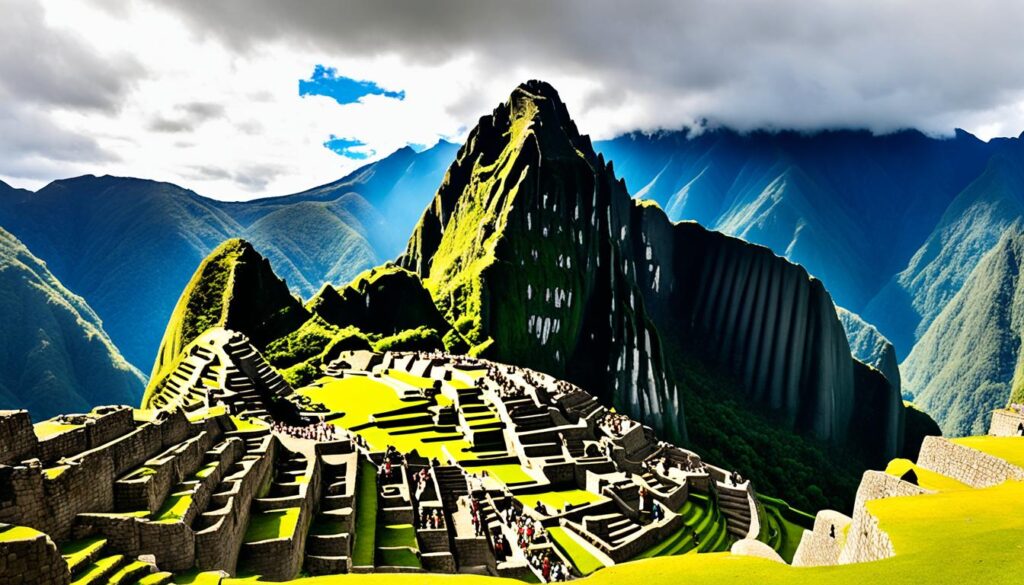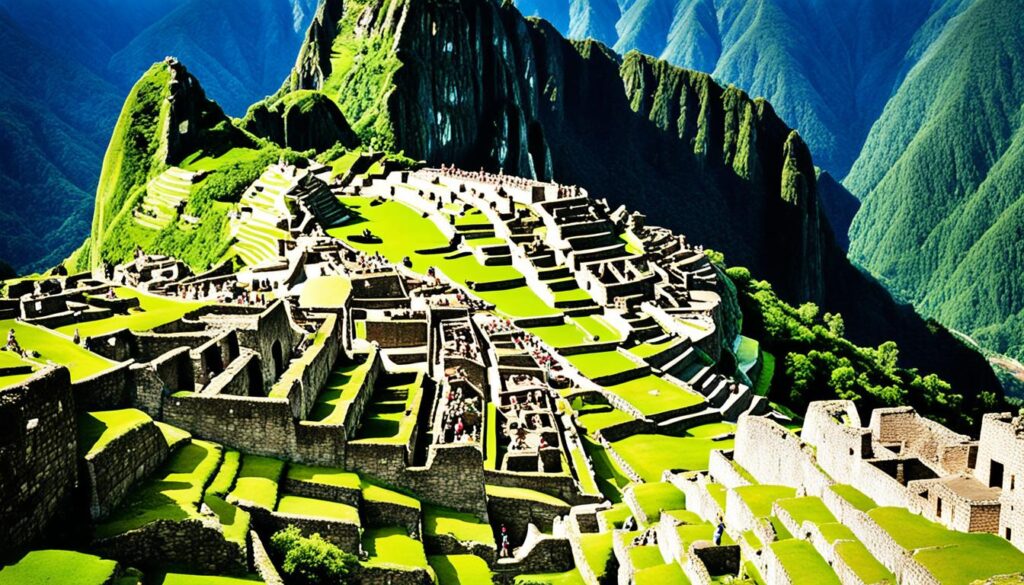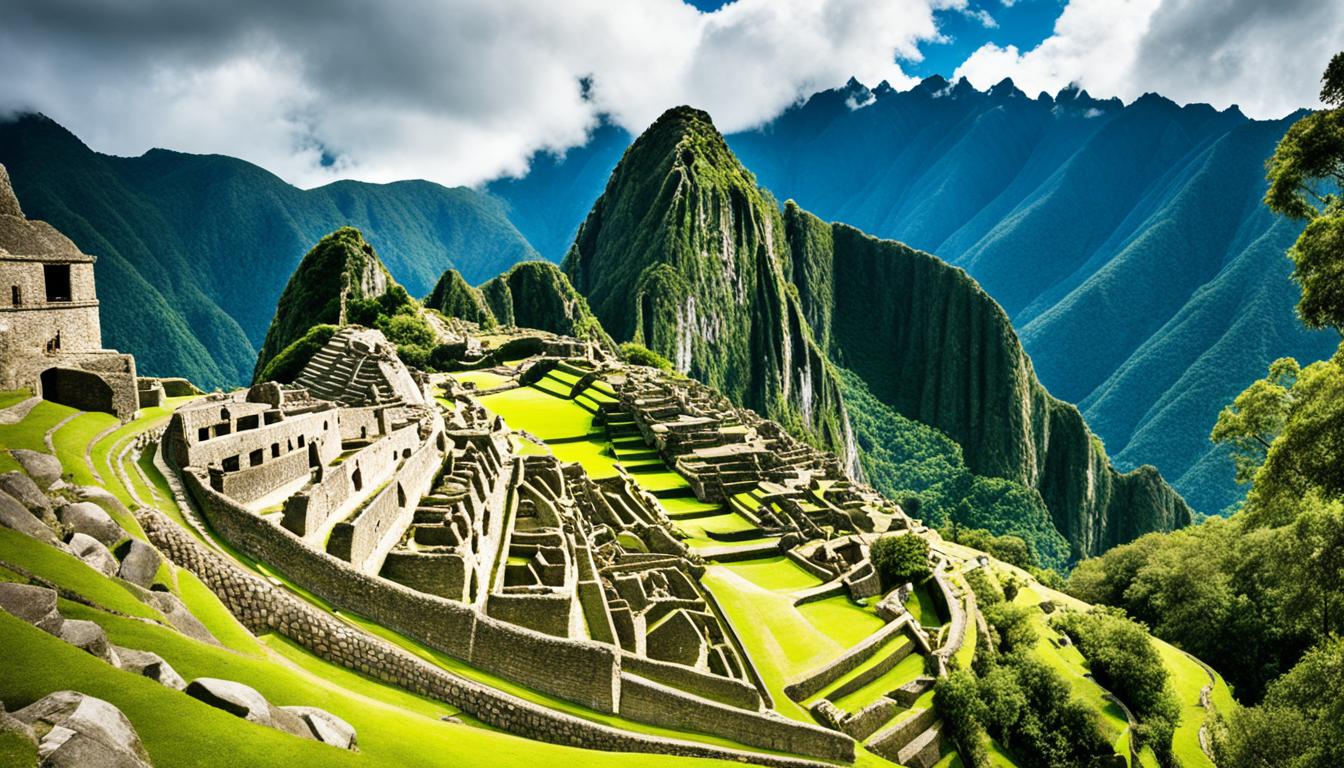Machu Picchu, the famous Inca citadel in Peru, welcomes hundreds of thousands of visitors yearly. This has brought both wonder and challenges for its management and conservation. The site spans 32,592 hectares of mountains and valleys. Built in the 15th century, it was left behind when the Inca Empire collapsed in the 16th century. Since its discovery in 1911, keeping it safe has been a big task.
With about 200 buildings, Machu Picchu shows off the Inca’s amazing engineering skills. It sits over 2,400 meters high. The area is home to many unique plants and animals. Now, it’s a big job for Peru’s Ministry of Culture to manage visitors and keep the site’s culture and nature safe.
Key Takeaways
- Machu Picchu is a vast historic site in Peru, covering over 32,592 hectares.
- It was built in the 15th century but left unused in the 16th century.
- Today, it boasts about 200 structures and is high up, over 2,400 meters above sea level.
- It’s a big challenge to keep the balance between visitors and preserving Machu Picchu’s heritage.
- Peru’s Ministry of Culture is working hard to protect this UNESCO World Heritage Site.
The Enigmatic Tourist Destination
Machu Picchu, an ancient Inca citadel in the Andes, has amazed people worldwide. Built in the 15th century, it was lost to the Spanish for years. Then, in 1911, American explorer Hiram Bingham III found it again. This find made Machu Picchu a famous spot in Peru.
Machu Picchu’s Discovery and Rediscovery
The tale of Machu Picchu’s rediscovery is thrilling. After being hidden for centuries, Bingham’s team found the ruins in 1911. This sparked a new interest in the Inca Empire and its skills in building and city planning. Since then, Machu Picchu has become a top spot for travelers everywhere.
The Inca Empire’s Legacy
Machu Picchu shows the Inca’s amazing building skills. Its stones fit together perfectly, showing the Inca’s advanced building methods. In 1983, it was named a UNESCO World Heritage Site for its culture and nature. The World Heritage Committee says it’s safe and well-kept, keeping its Inca legacy alive for the future.
Now, Machu Picchu is a top tourist spot. It won the World Travel Awards as the “Best tourist attraction in the world” in 2017, 2018, 2019, and 2021. Visitors can now explore more, like hiking to Huchuy Picchu, making their trip even more special.
“Machu Picchu is one of the most stunning and iconic archaeological sites in the world, a true testament to the ingenuity and vision of the Inca civilization.”
As more people visit Machu Picchu, managing the crowds is a big challenge. The next part will look at how to keep the site safe while letting visitors enjoy it.
Challenges of Tourism Influx
More people visiting Machu Picchu has brought big challenges. Millions come every year, causing more people, erosion, and damage to the ancient site. This has also made living costs go up for those near Machu Picchu.
Visitor Impact and Erosion
Too many tourists are wearing down the ancient paths at Machu Picchu. Trash left behind takes a long time to clean up, hurting the area’s ecosystem. To fix this, the Peruvian government and UNESCO have set limits on visitors and timed entry to lessen the strain on the site.
UNESCO’s Warnings and Visitor Limits
UNESCO warned the Peruvian government in the early 2000s about Machu Picchu’s damage, saying it might be listed as endangered. In response, a daily limit of 2,500 visitors was set, but some think fewer are needed to protect the site. The Lares Trek is a quieter way to get to Machu Picchu, offering a deeper cultural experience.
| Visitor Impact Metrics | Data |
|---|---|
| Visitors to Machu Picchu | Increased from low 100,000s in the early 1980s to 1.2 million in 2013, a 700 percent rise. |
| Daily Visitor Limit | 2,500 people, as agreed by the Peruvian government and UNESCO in 2008. |
| Inca Trail Permit Limit | 500 permits per day for the Inca Trail, including porters and guides. |
| Porters on Inca Trail | On average, 20 porters are needed for a group of 12 trekkers, carrying up to 20kg. |
| Visitor Time Limit | Maximum of four hours (six for hikers) allowed in the Machu Picchu complex. |
| Proposed Chinchero Airport | Plans to shuttle around five million passengers a year. |
“Overstaying visitors have been noted at Machu Picchu despite a maximum stay of four hours (six for hikers).”
Managing the tourism at Machu Picchu is complex. It needs a careful balance to keep the site’s culture and nature safe while helping the local economy. Keeping an eye on visitor numbers and promoting sustainable tourism is key to protecting Machu Picchu for the future.
Monitoring and Mapping Congestion
To understand and manage the many visitors to Machu Picchu, researchers use advanced methods. The Center for Sustainable Regional Transformation (CSRT) at Machu Picchu used GIS tools to track visitors and study congestion.
Visitor Tracking Techniques
They used new ways to watch how visitors move, like color-coded stickers, infrared counters, and feedback. This helped managers make smart choices about controlling crowds and managing visitors.
GIS and Heat Mapping
The CSRT team used ArcGIS to make heat maps and study visitor flow at Machu Picchu. These maps showed where it was most crowded. This helped managers plan better.
Real-Time Congestion Data Collection
They also set up a live web map for managers, guides, and visitors to see where it was busy. This system gives real-time info. It helps everyone make quick decisions to manage crowds.
Thanks to these new ways of tracking visitors, Machu Picchu’s team can keep the site safe and make visits better for everyone.
“The data-driven approach has enabled Machu Picchu’s administrators to make informed decisions about crowd control strategies and visitor flow management.”
Flexible Crowd Control Strategies
Machu Picchu’s capacity changes with the weather, who visits, and the season. To handle visitors well, a flexible, data-based approach to crowd control is key. This method helps manage the flow of people and protects this famous Inca site.
Network Analysis for Route Optimization
A permanent system tracks where visitors go and how crowded it gets at Machu Picchu. By using network analysis, the site’s team can change paths and experiences for visitors. This makes sure people spread out better, reducing crowding and improving their visit.
At Machu Picchu, flexible strategies tackle the issue of changing visitor numbers. By planning better routes, managers can handle more tourists without harming the site. This keeps the balance right between protecting the site and welcoming visitors.

Using these smart crowd management methods is vital for Machu Picchu’s future. By being quick to adapt, the site’s team can keep this world wonder safe for years to come.
preserving Machu Picchu
Machu Picchu is a wonder of the Andes Mountains, showing the Inca Empire’s genius. It’s also a delicate ecosystem that needs careful protection. As a top tourist spot, it must balance visitors with protecting its culture and nature.
Preserving the Architectural Marvel
The stones of Machu Picchu are at risk from millions of visitors each year. To keep it safe, we need to fix paths, strengthen walls, and manage visitors well.
Protecting Biodiversity and Habitats
Machu Picchu sits in the Andes and near the Amazon, full of plants and animals. Keeping its ecosystems safe is key to its status as a World Heritage site.
Rules help make tourism sustainable, like no plastic bottles, staying on paths, and not bothering wildlife. Several companies focus on protecting the site and respecting local ways, letting visitors enjoy Machu Picchu safely.
Keeping Machu Picchu’s architecture and nature safe is hard but vital. It protects the Inca legacy and the unique ecosystems. With teamwork, eco-friendly tourism, and conservation, we can keep Machu Picchu amazing for future generations.
Balancing Tourism and Conservation
Promoting sustainable tourism at Machu Picchu is key to keeping the site’s culture and nature safe while welcoming more visitors. Peru is adding ten new ways to get to Machu Picchu from June 1 to October 15, 2024, and on December 30 and 31, 2024. Now, up to 5,600 visitors can visit Machu Picchu every day. Machu Picchu is now the first place to be officially carbon-neutral. Tourists can get help 24/7 through WhatsApp (+51 944-492-314) thanks to PROMPERÚ. The new paths aim to spread out visitors better, easing the crowds at main entry points. There’s an infographic for tourists to plan their visit better. Machu Picchu’s efforts match a worldwide move towards eco-friendly tourism. Peru’s smart visitor management could make it a top example in responsible tourism. This could change how other famous World Heritage Sites handle tourism.
Sustainable Tourism Initiatives
Machu Picchu is a top historical spot, visited by many. It’s vital to have sustainable tourism here to lessen harm to the environment, keep the culture safe, and help the local economy. Too many visitors can harm the Inca buildings at the site. Rules are in place to control how many people come and to encourage sustainable tourism at Machu Picchu. It’s hard to manage visitors without hurting the site’s original state. It’s tough to balance the money from tourism with protecting the site. At Machu Picchu, too many tourists mean more trash and more energy use. Limiting the number of visitors is suggested to protect heritage sites. Encouraging visits during off-peak times can ease the crowds. Teaching visitors about the site’s importance is key for responsible tourism. Getting the local community involved in tourism can help them and support sustainable economic growth.
“Peru’s proactive measures to enhance visitor management could position the country as a leader in responsible tourism practices.”
The Santa Teresa Bridge Controversy
The Santa Teresa Bridge, built near Machu Picchu, has sparked debate. It was meant to help the Santa Teresa community by improving access and creating jobs. But, it has also worried people about more tourism and development harming the area around Machu Picchu.
Groups like the World Bank’s Vilcanota Valley Rehabilitation and Management Project don’t support the bridge. They fear it will bring more cars and hurt the protected area. The argument over the Santa Teresa Bridge shows the tricky balance between helping local areas and protecting Machu Picchu, a site that welcomes 2,500 visitors every day.
Local Development vs. Environmental Concerns
After a flood in 1998, Santa Teresa lost a key bridge. The new Santa Teresa bridge aims to boost tourism and end local monopolies. Yet, its building has worried conservation groups and UNESCO about its effect on Machu Picchu. Now, groups are trying to find a middle ground to limit car use on the bridge. This way, they can support local growth and protect the environment.
The debate over the Santa Teresa Bridge shows the tricky balance in managing Machu Picchu. The bridge was meant to help the local people, but it has raised concerns about its impact on the ecosystem and heritage of Machu Picchu’s buffer zone. Finding a solution will need a careful balance between the local community and preserving this Inca landmark.
“The Santa Teresa Bridge controversy highlights the delicate balance between promoting local development and safeguarding the cultural and natural heritage of Machu Picchu, a UNESCO World Heritage Site.”
UNESCO’s Role in Preservation
Machu Picchu became a UNESCO World Heritage site, helping in its preservation. UNESCO helps protect and manage sites that are culturally and naturally important. For Machu Picchu, UNESCO gave guidelines on visitor limits, building, and how to keep it safe.
UNESCO’s work has been key in managing tourism and protecting this famous site. If Machu Picchu is put on the endangered list, Peru must do more to protect it.
World Heritage Site Designation
In 1983, Machu Picchu was named a Historic Sanctuary. It’s important for many reasons, including its culture and history. Hiram Bingham found Machu Picchu in 1911, making him the first Western scholar to see it.
Guidelines and Recommendations
UNESCO gave the Peruvian government rules for keeping Machu Picchu safe. These rules help manage the many visitors, over 75,000 each year. UNESCO also helps control how many people can visit and how to keep the site in good shape.

Peru has 13 UNESCO World Heritage Sites, including Machu Picchu. Built in the 15th century, it’s known for its amazing engineering and architecture. UNESCO’s work is vital in managing tourism and keeping the site safe.
Future Challenges and Solutions
Machu Picchu is getting more popular by the year, and it faces big challenges ahead. The main issue is too many visitors causing damage to the site. To fix this, we need to limit the number of visitors, offer new experiences, and use smart ways to control crowds.
Addressing Overcrowding and Erosion
Peru plans to let more people visit each day, from 3,044 to 5,600. They will also change visiting times and add new spots to see, making it better for everyone. This will help spread out the visitors and make their experience better. They will also manage visitors better during busy times.
This change comes from working together with different groups to protect Machu Picchu. They want to keep it safe for the future by following international rules.
Promoting Responsible Tourism
It’s also important to teach visitors how to visit without harming the site. Encouraging travel that doesn’t harm the environment is key. Peru aims to cut carbon emissions by 45% by 2030 and be carbon neutral by 2050. Over 40 companies in tourism are already working on being carbon neutral.
Planting one million trees to help the environment shows Peru’s commitment to green tourism. This shows they care about the planet and want to keep Machu Picchu safe for the future.
By tackling overcrowding and erosion, and promoting responsible tourism, Machu Picchu can stay a great place to visit. Everyone working together is key to keeping this amazing site safe for the future.
Safeguarding Machu Picchu’s Legacy
Machu Picchu sits high in the Andes Mountains of Peru. It’s a symbol of the Inca civilization’s genius and strength. With millions visiting each year, saving Machu Picchu’s culture and nature is now a top goal.
Collaborative Efforts for Conservation
Keeping Machu Picchu safe for the future needs everyone working together. This includes the Peruvian government, conservation groups, the tourism sector, and local people. They use data and sustainable tourism to protect the site’s culture and nature.
Preserving Cultural and Natural Heritage
In 1983, Machu Picchu was named a UNESCO World Heritage Site. This highlights its importance worldwide. Experts work hard to keep the Inca’s masterpiece safe. They also protect the site’s plants and animals, including endangered ones.
Sustainable tourism helps local communities and keeps Machu Picchu’s culture alive. To protect the site, there’s a limit on visitors. Tourists must stick to certain paths and have guides.
“Preserving Machu Picchu’s cultural and natural wonders is a global task. Together, we can keep this iconic place a symbol of the Inca’s creativity and strength for years to come.”
More people visiting Machu Picchu means we must work harder to protect it. By using sustainable methods, better managing visitors, and protecting its resources, we can keep Machu Picchu’s legacy alive for everyone.
Conclusion
Machu Picchu, a stunning Inca citadel in the Andes, draws visitors from all over the world. UNESCO named it a World Heritage Site in 1984 and one of the New Seven Wonders of the World in 2007. But, its popularity brings challenges, like overtourism, which harms the environment and ruins.
With new monitoring and management, Peru and the world can protect Machu Picchu’s heritage. UNESCO calls it a World Heritage site for its preservation and conservation efforts. By balancing tourism with conservation, Machu Picchu can keep inspiring us while staying protected.
Peru depends a lot on tourism, especially from places like Machu Picchu, which brings in a lot of money. But, it’s hard to make money from tourism without hurting Machu Picchu’s nature and culture. Tourists often damage trails and buy the wrong souvenirs. By supporting sustainable tourism and working with local communities, we can keep Machu Picchu’s legacy alive for the future.

